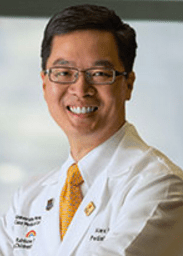UH Rainbow Oncologist Named to National “Moonshot” Advisory Group
May 04, 2016


May 2016
Pediatric oncologist Alex Huang, MD, PhD, from the Angie Fowler Adolescent & Young Adult Cancer Institute at University Hospitals Rainbow Babies & Children’s Hospital, has been named to a select working group advising the National Cancer Institute (NCI) on President Obama’s “moonshot” initiative to cure cancer. The “moonshot” initiative aims to speed current cancer research efforts and break down barriers to progress, making more therapies available to more patients, while also improving cancer prevention and early detection.Alex Huang, MD, PhD
Dr. Huang has been named to the Blue Ribbon Panel Working Group on Cancer Immunology and Prevention, one of seven groups of experts advising the NCI’s 28-member “moonshot” Blue Ribbon Panel. The cancer immunology and prevention group, which will begin its work immediately, includes 10 to 12 leading experts from across the U.S. During the next eight weeks, it will develop two or three recommendations for major opportunities that could lead to significant breakthroughs in the fight against cancer.
“Through your participation, you will be filling an essential role in advising the Institute and the National Cancer Moonshot,” said NCI Acting Director Douglas R. Lowy, MD, in inviting Dr. Huang to join the panel. Dr. Lowy is a previous recipient of the Harrington Prize for Innovation in Medicine, awarded by the Harrington Discovery Institute at University Hospitals and the American Society for Clinical Investigation.
“Having the opportunity to have some say over the direction of cancer research at the national level is fantastic,” says Dr. Huang, who is Theresia G. & Stuart F. Kline Family Foundation Chair in Pediatric Oncology and Associate Director of the Pediatric Hematology-Oncology Fellowship Program at Angie’s Institute. “It will allow me to bring attention to aspects of cancer that people may not be thinking about. UH Rainbow has been a national leader in adolescent and young adult (AYA) cancer, but nationally, the topic is not on the radar screen. My involvement on this panel will give us a national platform to highlight priority areas at UH – development of pediatric cancer immunotherapeutics at the UH Seidman Cancer Center and the AYA program at Angie’s Institute.”
Dr. Huang is also Associate Professor of Pediatrics, Pathology, General Medical Sciences & Biomedical Engineering at Case Western Reserve University School of Medicine. In addition, he is Co-Leader of the Hematopoietic and Immune Cancer Biology Program of the Case Comprehensive Cancer Center at Case Western Reserve University and holds a secondary appointment in General Medical Sciences (Oncology) within the Comprehensive Cancer Center. Dr. Huang completed his medical degree at Johns Hopkins University School of Medicine and his pediatrics residency training and pediatric oncology fellowship training at Johns Hopkins Hospital and the National Cancer Institute. He also completed post-graduate training in immunology at the National Institute of Allergy and Infectious Diseases. Dr. Huang also holds a doctorate in immunology from Johns Hopkins University School of Medicine. He has been at UH and Case Western Reserve since 2006.
The Blue Ribbon Panel and its seven working groups will make their recommendations to the National Cancer Advisory Board later this summer. Ultimately, this group will use the Blue Ribbon Panel’s findings and recommendations to provide final recommendations to the NCI Director.
Dr. Huang says he considers his participation in the “moonshot” working group as a chance to think big.
“One of the things that really impresses me about science has nothing to do with biomedical science,” he says. “Through the combination of meticulous data gathering and computer models, we can predict down to the degree what Cleveland weather is going to be for the next five days. With the advances now possible through precision medicine, can we use a similar big data approach to help predict whether an individual patient will respond to one therapy and not the other? Can we have enough confidence to say – 80 percent of patients will respond to this therapy, but you belong to the 20 percent who won’t and you should bypass it. The thing is to think about things that may be impossible right now, but may be possible with enough resources and input of talented people from different scientific disciplines.
Tags:


